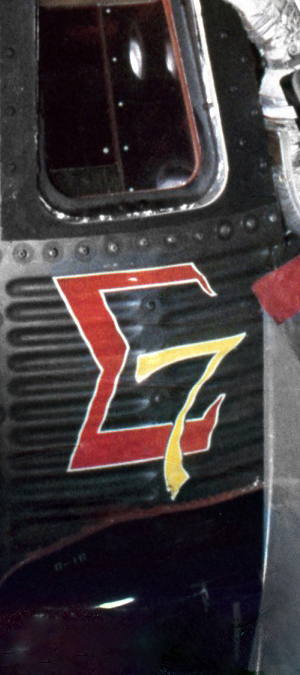 advertisements advertisements
|

|
'Sigma 7' at 50: Retro Space Images recall 5th US manned spaceflight
October 3, 2012 — Fifty years ago, the United States launched its fifth astronaut into space.
Walter M. "Wally" Schirra, Jr. rode his one-man Mercury spacecraft atop an Atlas rocket to orbit on Oct. 3, 1962. The nine-hour mission on the "Sigma 7" capsule was the longest to date for a U.S. flight and set the stage for the day long, final mission of the Mercury Program that followed.
Schirra, whose choice of the Greek letter "Sigma" for his spacecraft's name was meant to reflect his flight's focus on technical evaluation, wrote in his biography that he strove for "engineering excellence." To that end, the almost flawless flight of Sigma 7 ended with a nearly-perfect splashdown, landing just half a mile (0.8 kilometers) from the Navy's recovery ship.
"I think they're gonna put me on the number 3 elevator" of the aircraft carrier the USS Kearsarge, Schirra joked of his parachute-assisted descent. It could have been the ultimate of Schirra's "gotchas" — jokes that he infamously pulled on his friends, colleagues and later crewmates.
He could fall victim to them, too. Just three minutes into the Mercury-Atlas 8 mission, capsule communicator, or capcom, Deke Slayton radioed Schirra with a simple-to-ask but complicated-to-answer question, "Hey, Wally, are you a turtle?" A tradition carried over from World War II pilots, the correct reply, "You bet your sweet ass I am!" was not something Schirra could broadcast to the world below. The penalty for not responding, however, was having to buy all those listening a drink of their choice.
Not missing a beat, Schirra switched from live radio to his onboard recorder and spoke the "correct answer," as NASA's official transcript would later note.
Beyond the jokes, Schirra conducted observations of the planet Mercury, tracking its passage as seen through the upper layers of Earth's atmosphere, and flew the first Hasselblad camera in space, a model he himself chose and purchased at a local Houston photo shop.
Schirra also bought and wore on Sigma 7 the first Omega Speedmaster watch to fly in space, initiating the chronograph's long legacy as the timepiece of choice for both astronauts and cosmonauts to this day.
Schirra, who went on to fly Gemini and Apollo missions — the only astronaut to fly all three of NASA's early piloted spacecraft — died in May 2007 at age 84. His Mercury capsule, Sigma 7, is today on display at the U.S. Astronaut Hall of Fame in Titusville, Fla., where Schirra is honored as one of the Hall's original inductees.
Retro Space Images, which recently released for sale an archive of almost 500 images from the Mercury-Atlas 8 mission, chose the following photos to visually retell the 50 year old flight of Wally Schirra on Sigma 7. |
|

|
 
Walter M. "Wally" Schirra, Jr. was one of the seven Mercury astronauts named by NASA in April 1959. A captain in the U.S. Navy, Schirra was 39 years old when he became the fifth American in space aboard the Mercury-Atlas 8 mission on Oct. 3, 1962. |

Here, Schirra shows his Mercury spacesuit helmet to his 12-year-old son, Walter M. Schirra, III. Together with his wife Jo, Schirra had two children, including a daughter Suzanne, who had just turned five, four days before he launched on Sigma 7. |

Schirra was originally scheduled to launch on Sept. 28, 1962, but a malfunctioning fuel-control valve delayed his flight. His booster for the mission, an Atlas LV-3B, or Atlas D Mercury Launch Vehicle, is seen here leaving the General Dynamics facility in San Diego, Calif. |

The spacesuit that Schirra wore, the Navy Mark IV, was a full-body pressure suit originally developed by the B.F. Goodrich Company and the U.S. Navy to protect pilots in high-altitude fighter aircraft operations. Its silver color was from an aluminum-coated nylon. |
 
(Above, right) President John F. Kennedy (at right) toured Cape Canaveral's Launch Complex 14 with Schirra on Sept. 11, 1962, where he saw the Mercury-Atlas 8 launch vehicle being prepared for flight. |


The Mercury astronauts didn't design or wear mission patches as later flight crews would, but working with RCA artist Cece Bibby, logos were added to the spacecraft. Here Bibby hand paints Schirra's "Sigma 7" insignia on the Mercury capsule. |

Schirra rode the rocket, but it took a mission support team on the ground to make the Mercury-Atlas 8 mission a success. Here, Schirra (third from right in front row) poses at Complex 14 with his launch team. |

Dee O'Hara (at right) served as the first nurse to NASA's astronauts, including Schirra. She famously became the subject of a "gotcha" when Schirra and fellow astronaut Gordon Cooper presented her an enormous "5 gallon urine sample" — iodine-colored warm water. |

 

 
Schirra launched at 7:15:11 a.m. EST on Oct. 3, 1962 from Complex 14 at Cape Canaveral, Fla. The Sigma 7 capsule obtained a velocity of 17,557 miles per hour and an altitude of 175 miles, traveling almost 144,000 miles in the course of six orbits. |

Schirra made the first pin-point landing from space, splashing down in the Pacific Ocean, 273 miles northeast of Midway Island, 4.5 miles (7.2 kilometers) from the target point and just half a mile from the USS Kearsarge, the mission's prime recovery ship. |
 
Schirra and Sigma 7, as seen in their post-flight conditions onboard the USS Kearsarge, Oct. 3, 1962. |

Schirra visited Washington, D.C., to receive the NASA Distinguished Service Medal from President Kennedy on Oct. 16, 1962. |
|

© 1999-2025 collectSPACE. All rights reserved.
|
|

|

|
